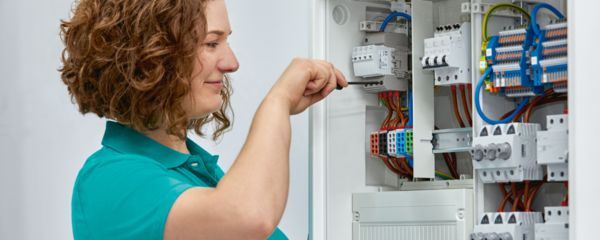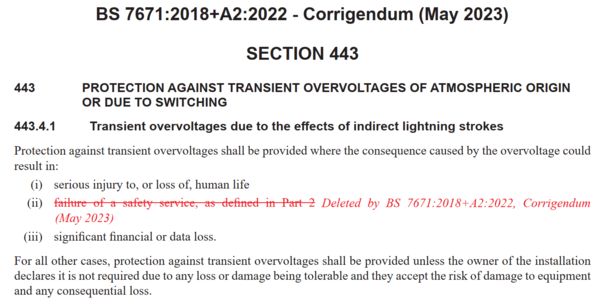BS7671:2018 Amendment 2

April 2022 saw the publication of “Amendment 2” of the 18th Edition of BS7671. More commonly known as the “wiring regs” BS7671 is technically not a legal document, but it does provide valuable guidance and information for anyone working on an electrical installation. Such installations need to be designed and installed to the latest regulations to ensure the protection of persons, livestock and property.
When the 18th Edition came into effect on the 1st of January 2019, it set out a list of circumstances under which surge protection had to be installed. This effectively led to an uptake in the usage and installation of surge protective devices (SPDs) in commercial and domestic installations.
It is chapter 443 of the standard that deals with protection against transient overvoltages of atmospheric origin or due to switching, and within this regulation 443.4.1 covers the different circumstances where protection against transient overvoltages is required.
In short, Amendment 2 now lists 3 “Shall Bes” when considering if surge protection is needed. BS7671:2018 Amendment 2 now states:
*“Protection against transient over-voltages shall be provided where the consequence caused by over voltage could result in:
i. Serious injury to, or loss of, human life
ii. Failure of a safety service, as defined in Part 2
iii. Significant financial or data loss”
Importantly the requirement to carry out a risk assessment has been completely removed effectively meaning the installation of SPD’s can no longer be decided via a calculation.
Similarly removed is the exemption for single dwellings not covered by i to iii above. They now also need to be considered along with all other electrical installations and in practice this would be down to the owner of the dwelling or installation to declare that surge protection is not required due to any loss or damage being tolerable.
Safety Services
It is arguably the 2nd point above (ii) relating to the protection of a safety service that is the most significant change. To understand this, we need to know what a “safety service is. BS7671 defines a safety service as:
An electrical system for electrical equipment provided to protect or warn persons in the event of a hazard, or essential for their evacuation from a location.
So, examples of a safety service will include fire alarm systems, fire rescue service lifts, fire services communications, emergency lighting, gas detection systems, CCTV, public address (PA) systems, essential medical systems, smoke ventilation systems All the kind of systems that would be commonplace in schools, hotels, hospitals, airports, public transport hubs, museums, and public libraries to name just a few. Such safety services have not been explicitly mentioned in the wiring regs up until now.

As previously documented, the requirements to carry out a risk assessment has been completely removed effectively meaning the installation of SPDs no longer require to be decided via a calculation.
Similarly removed is the exemption for single dwellings not covered by i to iii above. They now also need to be considered along with all other electrical installations and in practice this would be down to the owner of the dwelling or installation to declare that surge protection is not required due to any loss or damage being tolerable.
Section (ii) - Safety Services
Deletion of the section (and further referenced within Table 443.2 Required rated impulse voltage of equipment (Uw) on page 8 of the corrigendum) removes examples of safety systems – such as alarm panels, computers and home electronics – Further reference is made on page 9 Section 534 Devices for Protection Against Overvoltage – Regulation 534.4.1.1 details the removal of fire/security alarm systems.
So, previously detailed examples of a safety service will include fire alarm systems, fire rescue service lifts, fire services communications, emergency lighting, gas detection systems, CCTV, public address (PA) systems, essential medical systems, smoke ventilation systems. All of these types of systems that would be found and be commonplace in use in schools, hotels, hospitals, airports, public transport hubs, museums, and public libraries to name just a few. Such safety services have not been explicitly mentioned in the wiring regs up until now but have now had the amended reference for deletion. Careful consideration must be made to ensure the correct levels of protection are still employed within these types of installations for the following reasons:
An electrical system would still require for electrical equipment provided to protect or warn persons in the event of a hazard, or essential for their evacuation from a location within the other safety systems. This is a requirement if there are Lightning Protection Systems installed within installations thus requiring compliance with BS EN 62305 Parts 1 to 4.
The changes made and the removal of this now makes a different perspective regarding the highlighted items detailed with the corrigendum, the ones not referenced and the requirements that these could potentially fall under. As the majority of these services employ the use of sensitive electronic components – Protection should be considered to prevent not only a loss of service, but the potential of financial cost/data loss if such systems were to fail. As a vast majority of these systems could potentially fall under an obsolescence category, the re-engagement of the services may be hindered or have additional costs for upgrades, potentially resulting in long periods of downtime thus falling under relevance within section (iii).
Surge protection basics Click on the link below If you would like more information on the basics of surge protection, the technology, standards and how SPDs actually work
Surge protection basics

Photovoltaic Systems
One further change that affects surge protection can be found in Part 7 of BS7671. Chapter 7 deals with special installations or locations such as swimming pools, caravans and motor homes, agricultural and horticultural premises, marinas, and solar PV to name a few. It is the last of these installations where surge protection is mentioned in amendment 2.
Regulation 712.443.103 Protection against transient overvoltage, states – Where protection against transient overvoltage is required by section 443, such protection shall also be applied to the DC side of the PV installation. In plain English if the entire installation requires surge to be installed to comply with section 443 then it will be a requirement that SPDs are installed on the DC side of a PV array to protect the inverter and the PV panels.
Surge protection devices designed to be used to protect the DC side of a PV system are designed to a different standard to those designed for use in a low voltage installation and typically have nominal voltage ratings of 1000 or 1500VDC.
Your Advantages
- Full range of 18th Edition compliant surge protection devices for 1, 2 & 3 phase networks
- Solutions for all standard power supply systems, TN-C, TN-S, TT, IT
- Superior system availability, thanks to spark gap technology without line-follow current
- Consistent protection across all protection levels, thanks to coordinated protective devices
- Space-saving and inexpensive installation, thanks to slim design
- Back up fuse free solutions up to 315A rated installation
- Predictive maintenance thanks to removable and testable plugs using Checkmaster
